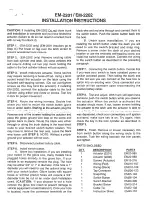
15
GB
Introduction / Safety
r
Power cable with mains plug
t
Charging cable with 12 V plug
y
“+”-pole connecting cable ring terminal (red)
u
“–”-pole connecting cable ring terminal (black)
i
“+”-pole alligator clip (red)
o
“–”-pole alligator clip (black)
p
Connecting cable ring terminals
[
Connecting cable connecting terminals
]
Connection adaptor
q
Technical data
Primary
Rated input voltage:
220 - 240 V ~ 50 / 60 Hz
Starting current:
< 50 A
Rated input current:
max. 1.2 A (actual value)
Power consumption:
135 W
Secondary
Rated compensating
voltage:
12 V
24 V
Charging voltage:
28.8 V / 29.4 V (±2%),
14.4 V / 14.7 V (±0.25 V),
13.6 V / 16.5 V (±0.25 V)
Charging current:
7 A (±10%), 5 A (±10%),
3.5 A (±10%), 3 A (±10%),
1.5 A (±10%)
Rated
equalising current:
3.5 A / 7 A
Ripple**:
max. 150 mV
Reverse current*:
< 5 mA (no AC input)
System of protection: IP 65 (dustproof,
waterproof)
Battery type:
12 V + 24 V-lead-acid
batteries (AGM, GEL, MF,
open and VRLA)
Battery capacity:
12 V : 14 Ah - 230 Ah /
24 V : 14 Ah - 120 Ah
Fuse (internal):
10 A
Noise level:
> 50dB
Ambient temperature: 0 - +40 °C
Dimensions:
200 x 80 x 50 mm (l x w x h)
* = Reverse current is the current that the charger
uses from the battery when it is not connected
to the mains current.
** = Noise figure is the nuisance value of the current
and voltage.
q
Safety
Safety information
J
Do not operate the appliance with a damaged
cable, power cord or plug.
m
Caution!
A damaged power cord causes
danger to life by electric shock.
J
If damaged, have the power cord repaired by
authorised and trained technicians only!
J
Do not allow toddlers or children near
the charging station without super-
vision! Children cannot assess the
potential danger in the handling of electrical
equipment.
J
Children or persons who lack the knowledge or
experience to use the device or whose physical,
sensory or intellectual capacities are limited
must never be allowed to use the device without
supervision or instruction by a person responsible
for their safety.
J
Explosion hazard!
Protect yourself
from a highly explosive oxyhydrogen
gas reaction! Gaseous hydrogen
can leak from the battery during the charging
and discharging process. Oxyhydrogen gas is
an explosive mixture of gaseous hydrogen and
oxygen. The result is the so-called oxyhydrogen
reaction upon contact with open fire (flames,
embers or sparks)! Carry out the charging or
discharging procedure in a wellventilated room
protected from the weather. Make sure that there
are no sources of open fire (flames, embers or
sparks) in the vicinity when charging or discharg-
ing batteries!
J
Danger of explosion and fire!
Make
sure that explosive and flammable
substances e.g. petrol or solvents
can be ignited when using the charging station!
m
Danger of chemical burns!
Protect your eyes
and skin against chemical burns caused by acid
(sulphuric acid) upon contact with the battery!
Do not look directly at the connected battery.
battery_charger_7.0_Content_EU.indd 15
09.12.08 16:59





























